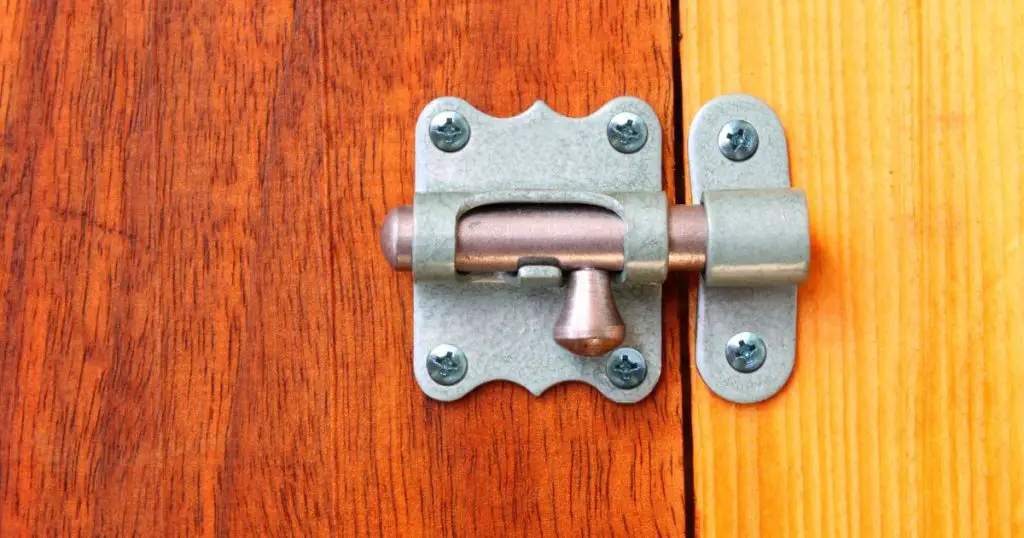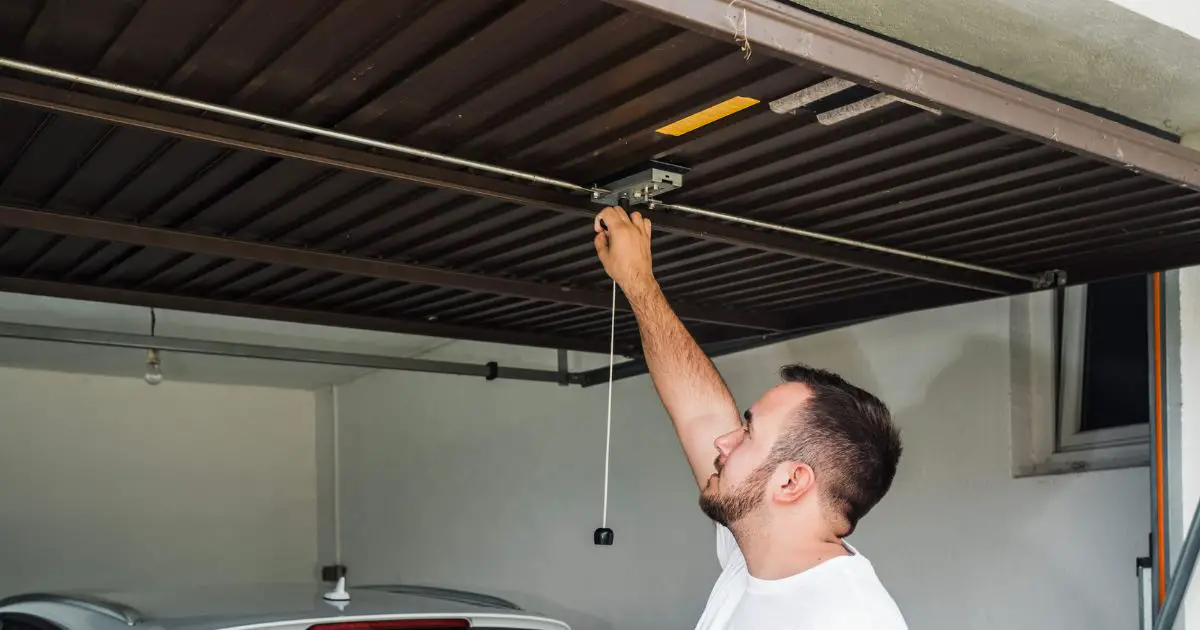Many garages also double as tool sheds and can house several valuable items. Besides providing a safe place for you to park your car, it may also serve as an area for you to work and store your tools and tinkering supplies. If someone breaks into your garage, they might also be able to enter your house, since most garages have doors leading inside. This makes garages the most vulnerable area of the house in terms of security.
Many modern garage doors come equipped with garage openers that act as garage door locks as well. This may seem a better option than manual locks, but burglars have new technology to open even automatic garage doors. You may need to take further security measures in case the garage door opener breaks.
Fortunately, there are a few relatively easy techniques you can apply to make your electronic garage door more secure against any intruder.
Can Your Garage Door Lock?

Contemporary garages with electronic door openers can lock the door as we mentioned before. These openers are activated by a keychain remote, keypad, or garage door monitor that can detect only your vehicle. Without these devices, the door will not open.
If you do install an additional manual lock, everyone who uses the door must know about it. The door may be damaged if opened with a remote or keypad while the lock is on.
Considering there are multiple ways to lock the garage door from the inside, I recommend that you choose one – or more than one – method to be extra secure.
Top Recommendations to Secure Your Garage Door
There are many ways to lock a garage door manually and here we highlight a few of them for your peace of mind.
Tools and Materials Needed
- Hole punch
- Flathead screwdriver
- Self-drilling screws
- Impact drill
- Wire cutter
- Key padlock
- C-clamp
- Zip ties
- Slide lock
- Step ladder
Use Zip Ties to Lock the Release Level

Automatic garage door openers are connected to an emergency release lever. The release lever is designed to open garage doors manually in case there’s a power outage. Using a cable tie or zip tie in the emergency release lever is the easiest and cheapest way to ensure burglars cannot access your garage door using this lever.
Any trespasser with nefarious intentions can open your garage door by jimmying in a hanger through the opening at the top and using it to hook the lever and pull it. This method is often referred to as Fishing.
Here’s how zip ties and scissors can stop burglars from Fishing:
Step 1: Disconnect the garage opener.
As a safety precaution, you need to unplug your garage door opener to prevent it from accidentally opening the door and hurting you.
Step 2: Identify the emergency release lever and cord.
Depending on the type of garage opener the lever might be located on top of the garage door or at the end of the rail track. There should be an emergency release cord attached to it and swings from the two horizontal bars that hold the door in the open position.
Step 3: Secure the release rope with a zip tie.
Use the zip tie to secure the rope. You’ll notice there’s a hole where the rope is buddled on the trolley release arm. The trolley arms help the door to move upwards when engaged and we need to prevent this latch from shifting when engaged.
Step 4: Double-secure the cable tie by looping through the trolley carriage hole.
The emergency lever is attached to the trolley carriage. It is the principal mechanism for raising the garage door. The spring and latch are connected by a hole in the trolley carriage so this hole is used to secure the cable tie to prevent the emergency release lever from working.
Step 5: Tie up the zip tie.
Knot the zip tie tightly and cut off any excess with scissors. It is best to use new zip ties as old ones may break down on using force.
This method is best if you are planning to leave home for a long time on a vacation or holiday. It’s quick, easy and requires almost no effort or expense and keeps your garage secure in your absence.
Install a Slide or Latch Lock

Adding a latch or side bolt on the inside of your garage door is the most secure form of manually locking the garage yet. It’s DIY but you must have some tools handy. Here are simple steps to get it right on your own:
Step 1: Locate a knockout template on the vertical tracks.
On the vertical tracks, you should find a small knockout template. You’ll find it somewhere in the lower portion of the door, located in the second section. Using a drill, you can remove this template to allow the latch onto the track. Many doors may not need such a procedure as they would already have a hole in the tracks.
Step 2: Drill holes in the wall for the latch.
Place the lock against the garage door to determine where holes need to be made. Mark the hole onto the wall with a pencil and then drill screw holes at the markings. Make sure the latch will go into the hole in the track at this position.
Step 3: Screw in the latch lock.
Now align the lock with the pre-made holes in the wall. Then carefully drive in the self-drilling screws with a screwdriver or a drill. This will now allow you to secure the garage door from the inside.
Identify the knockout template that’ll be on the vertical tracks located on either side of the door. You’ll find it in the secondary portion at the bottom of the door
Padlocks for Locking Tracks
In just two steps and with an extra padlock at hand, you can secure your garage door manually. Here is how it works:
Step 1: Look for a hole in the vertical tracks.
As we mentioned in the method above, there should be a hole in the vertical tracks of your garage door on either of its sides. If there isn’t, you can make one with a drill – preferably just above the first garage door roller.
Step 2: Put a padlock in the hole.
Fasten a padlock through the hole to prevent the door from lifting on the tracks. Even if someone opens the door using the release lever the door won’t move on its rollers. Just keep in mind you have a padlock on when you open the garage door with a remote or keypad next time.
Secure the Exterior of the Door
It is highly recommended to secure your garage door’s exterior as well, this is so you’ll be reminded to unlock it before using the opener. There are two common ways to lock your garage door from the outside:
- Door component with a sliding bar lock and a T-handle or L-handle
- Getting a garage door defender bolted to the ground.
Extra Options for Garage Security
We’ve highlighted some easy methods to lock your garage door manually. but for times when you might forget you’ve locked it, we have a safer method as well. It involves installing Garage Door Armor to protect your emergency release lever from tinkering.
We’ve discussed ways how to lock a garage door but we haven’t talked about securing another door leading from the garage into the house. Locking the door to your garage is just as important in impeding unwanted entry into your house. So, make sure to secure all doors before leaving the garage.
Another point to mention is that windows in your garage may not be a great interior design choice in terms of security. Thieves may peek into your garage looking for expensive tools and items inside your car. They could also scope if someone is home or not, that’s why it is best if you remove those windows or at least used frosted ones on the garage door. It’s also safer to turn on garage lights at night to warn off any potential burglars.
Another security option for garage protection is installing a security camera or motion sensor outside your door. A good motion sensor provides an alarm or signal on your device that an intruder is forcing entry into your garage. The camera will also help in surveillance and image any burglar in case a break-in still happens.
Conclusion
An electronic garage door provides sufficient security as long as you keep the remote or code to yourself. But if this still doesn’t make you feel safe, we have discussed methods to further secure your garage manually. It’s a great option for when your automated system malfunctions or breaks.

